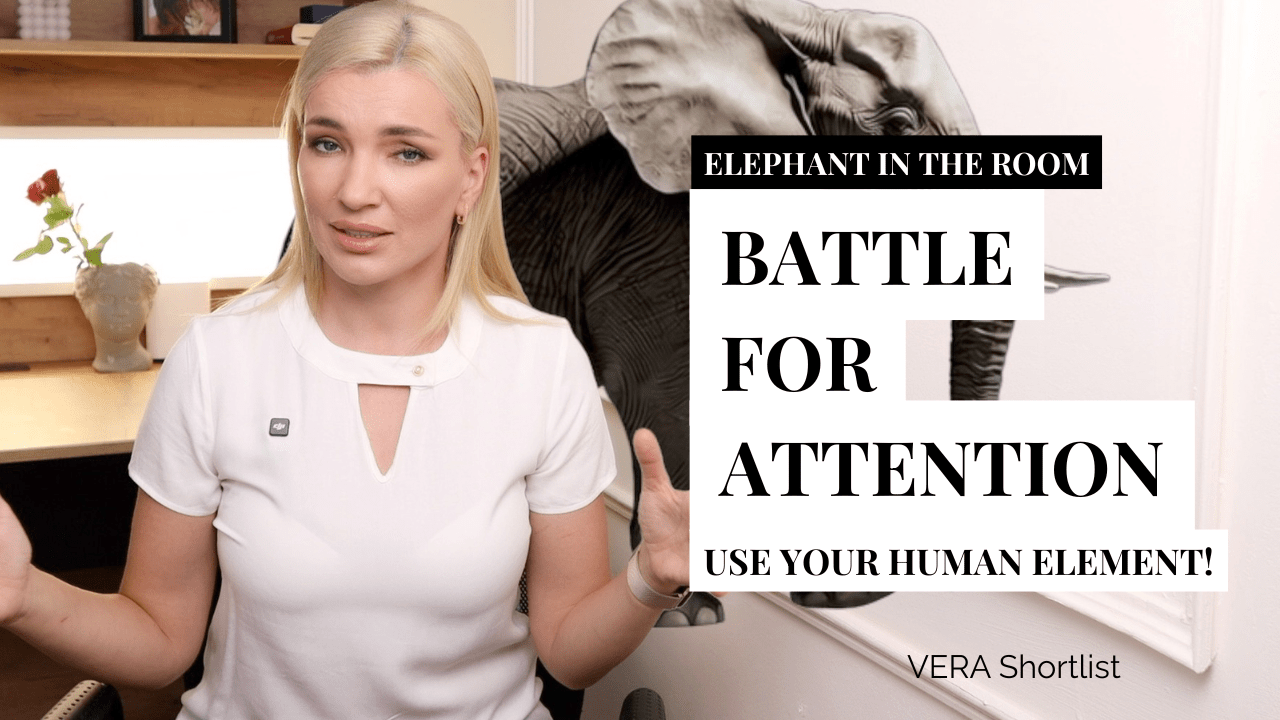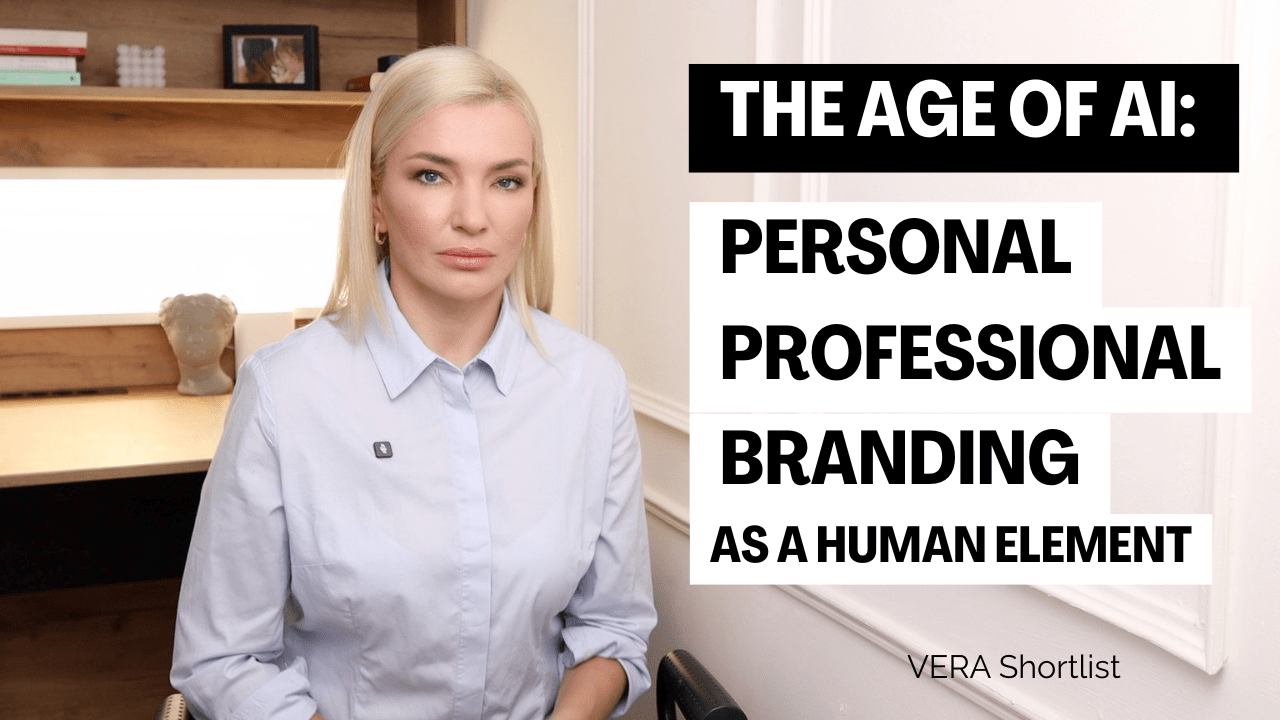Visibility vs. Credibility: What Chasing Attention Can Cost You

In the first two episodes of The VERA Shortlist, we talked about how brands must be discovered by AI and felt by people. Now, in Episode 3, we go deeper: visibility alone is no longer enough. Without credibility, visibility can even backfire: both in the eyes of algorithms and real humans. As we saw, according to the Edelman Trust Barometer 2024, 87% of users say trust determines brand choice. That tells us right away: being seen is only half the story; being trusted is the other, indispensable half.
We live in an era of “algorithmic attention,” where metrics like impressions or views tempt us to chase numbers. It feels satisfying to watch follower counts grow or ad impressions rise, and AI tools may reward volume in the short term. But if those metrics aren’t grounded in genuine value, the result is shallow: fleeting visibility that doesn’t convert into lasting relationships or real business. Both AI-driven search and human decision-making look beyond mere signals of “did someone click or scroll”… they ask, “Can I trust this brand?”
Below, we explore four common pitfalls that brands face when they prioritize visibility over credibility. Then, we discuss how to flip the script: build visibility on a foundation of real trust signals, so that attention turns into genuine connection and sustainable impact.
1. The Illusion of Shallow Content
First, consider how easy it is today to produce vast quantities of content. With AI assistants, templates, and cheap tools, one can churn out blog posts, social updates, and visuals endlessly. Yet the online world is already drowning: people see thousands of brand messages daily, reportedly between 6,000 and 10,000 impressions on average. In such a flood, most content becomes wallpaper… machines can index it, but humans ignore it. If your audience treats your posts like background noise, visibility alone won’t move the needle.
Besides, shallow content often lacks a clear point of view or emotional core. It may tick SEO boxes: keywords, headings, meta tags, but it fails to offer insight, fresh perspective, or genuine relevance. AI-driven systems are learning to recognize depth: beyond simple keyword matching, they assess semantic richness and reputation signals. When content feels generic or rehashed, it neither impresses people nor satisfies evolving AI criteria. Ultimately, quantity without substance wastes resources and may even harm credibility over time.
Worse, flooding channels with trivial updates can desensitize your own audience. When every competitor publishes something similar, attention erodes further. And if people perceive a brand as chasing volume rather than delivering value, trust diminishes. Authenticity demands focus: choose topics where you can contribute real expertise or distinctive viewpoints. In the AI era, depth and relevance matter more than ever: machines reward it, and people remember it.
Shallow content is a trap of the “visibility-first” mindset. Instead, aim for fewer but richer pieces: thoughtful analyses, real stories, case studies, or conversations that show why you care. That approach builds credibility gradually, so when algorithms surface your brand, the human on the other end finds substance worth exploring.
2. Fake Engagement and the Risks of Manipulation
Next, many brands fall into the temptation of engineered engagement: comment pods, reciprocal likes, or superficial “engagement rings.” At first glance, these tactics may boost apparent interaction and trick platform algorithms. But AI chatbots and advanced detection models are increasingly adept at spotting anomalies in engagement patterns such as sudden spikes, timing irregularities, or low-quality interactions signal inauthentic behavior. When such tactics are uncovered, both AI-driven recommendations and human observers lose trust.
Even before AI detection, fake engagement can erode reputation among peers and potential clients. Industry networks are tight; people notice when comments feel scripted or when a brand’s audience lacks genuine enthusiasts. Word travels: if your name becomes associated with superficial tactics, credibility suffers. In B2B or professional contexts, reputation often precedes formal proposals… your personal brand and company brand depend on authentic relationships.
Moreover, if AI flags suspicous engagement, your visibility may suffer in AI-generated shortlists or search features. AI systems weight signals like backlink quality, source reputation, and consistency of messaging over raw interaction counts. In other words, hollow engagement won’t help you rank in AI-driven discovery, and may even work against you if flagged as suspicious. Real engagement: comments indicating real thought, shares with genuine commentary, backlinks from trusted sources – builds credibility for both machines and humans.
The antidote is to foster organic conversations and genuine communities. Encourage feedback with real value: ask questions that matter, share behind-the-scenes insights, highlight client stories. These yield engagement that reflects true interest and trust. In an AI era, authenticity not only feels better, it performs better in discovery and decision-making processes.
3. Chasing Trends vs. Building a Steady Foundation
It’s tempting to jump on every hot trend:Web3 one week, ESG the next, then “AI-first” the week after. Trend-chasing can feel dynamic, but credibility is cumulative: it grows when audiences see consistent expertise over time. Frequent pivots can confuse both people and AI systems. For humans, inconsistent messaging undermines trust: if your brand constantly reinvents itself, audiences may wonder where you truly stand. For AI-driven discovery, fragmented content architecture signals lack of authority: algorithms look for coherent topical focus to recognize expertise…
Frequent repositioning also risks diluting your core strengths. When you chase the latest buzz without a clear link to your expertise or values, you miss the chance to deepen authority in areas that matter. A foundation built on trust signals:long-form thought leadership, case studies, genuine commentary on relevant developments accumulates over time. Trends can be incorporated, but only when they align logically with your established narrative. Otherwise, they become distractions rather than opportunities.
AI systems evaluate patterns: do your messages and content reflect a coherent, sustained topic area? Do backlinks and mentions cluster around consistent themes? When content shifts erratically, algorithms struggle to assign authoritative signals to your brand. Humans, too, feel disoriented when your messaging zigzags without clear rationale. Instead, use trends selectively: comment on them from your unique perspective, linking back to your proven domain. That way, you demonstrate relevance without sacrificing consistency.
Building credibility is a marathon, not a sprint. Steady messaging rooted in your core expertise and values creates a recognizable voice that audiences learn to trust. When you do address emerging topics, your perspective carries weight because it builds on a visible track record, both to people and AI-driven discovery tools.
4. Automation Without Emotion: Where AI Helps and Where It Hurts
AI can be a powerful assistant: it helps refine sentence clarity, optimize structure, generate summaries, and suggest metadata. Yet if you hand over the entire creative process to AI, you risk producing content that feels cold and detached. Machines can assemble technically correct copy, but they lack lived experience, nuance, and emotional resonance. Nielsen Norman Group research suggests that distinctive, emotionally resonant content is remembered far more than generic messaging.Similarly, emotional resonance can boost brand trust significantly. A page written solely by AI may check every SEO box but leave readers unmoved.
When content feels flat, people sense it even if they can’t pinpoint why. They engage less, share less, and ultimately trust less. AI-driven search may index such content, but if it lacks genuine perspective or anecdotes, humans won’t stick around. Search engines are also evolving: they assess context, reputation signals, and user feedback. If users quickly bounce or show minimal engagement, that signals lower value to algorithms.
That said, AI can and should support human creativity. Use it to draft outlines, suggest improvements, or handle routine editing. Then infuse the draft with your voice: anecdotes, reflections, specific examples, and emotional hooks that only you can provide. This hybrid approach ensures content remains machine-readable while deeply human. In this way, visibility gained through AI-assisted optimization rests on a bedrock of authenticity that builds credibility.
Remember: reputation is built layer by layer, not via shortcuts. Automation can speed certain tasks, but emotional connection comes from human stories, beliefs, and values conveyed sincerely. Strive for a balance: let AI handle structure, let you supply soul.
Building Visibility on Credibility
The alternative to chasing shallow visibility is to reverse the formula: start with credibility, then let visibility follow naturally. That means speaking in your own human voice even when AI helps with structure. Keep messaging consistent, gather genuine endorsements rather than inflated follower counts, and crafti content that is both machine-friendly and deeply human. As we said earlier, reputation is architecture: you lay one brick at a time through coherent, integrity-driven actions.
Begin by auditing your current content landscape: where do you have real expertise to share? Which stories or case studies illustrate your values in action? Use those as anchors. When you produce content, whether written, audio, or video, ensure each piece reflects those anchors, so algorithms pick up meaningful signals and people feel a true connection. Seek endorsements from reputable peers and clients; those third-party voices strengthen credibility in ways that algorithms and humans recognize.
Over time, consistent, credibility-first content accumulates into a robust presence: AI-driven discovery tools are more likely to shortlist brands with coherent signals, and when people arrive, they find substance worth exploring. Visibility then becomes not an end in itself but a byproduct of trust. Attention turns into engagement, engagement into relationship, and relationship into long-term impact.
In a world obsessed with “being seen,” choose instead to be trusted. Visibility without credibility is a hollow pursuit; credibility without visibility may go unnoticed. But credibility built first paves the way for sustainable visibility—where your brand is recommended by AI and embraced by people.
Sources & Further Reading:
- Edelman Trust Barometer 2024: trust determines brand choice for 87% of users edelman.com
- Google Search Central on AI and content: algorithms evaluate reputation, backlink quality, consistency google.com
- Red Crow Marketing: people see 6,000–10,000 brand messages daily redcrowmarketing.com
- Content Marketing Institute: rapid surge in AI-generated content and the need for meaningful planning contentmarketinginstitute.com
- Stanford Internet Observatory: AI detection of manipulated engagement patterns rand.org
- Nielsen Norman Group: emotionally resonant content is far more memorable and drives trust facebook.com




